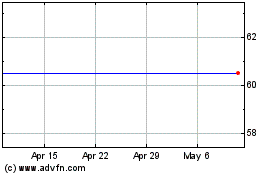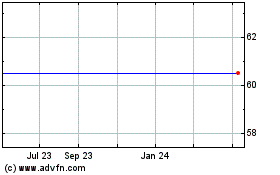LONDON—For years, Alvaro Privat was a loyal smoker of the brand
Montana. But when Montana's owner, British American Tobacco PLC,
folded the cigarette brand into another, Pall Mall, he barely
noticed.
"The color was the same, the taste was the same, the price was
the same," said Mr. Privat, an architect who lives in Lima,
Peru.
For BAT and rival Imperial Tobacco Group PLC, hanging on to
customers like Mr. Privat—even as the companies rid themselves of
small, local or just underperforming brands—is often an elaborate
marketing exercise that can take years to execute.
"Companies have realized that managing too many brands brings
additional complexity and cost," said Nirmalya Kumar, a visiting
professor of marketing at London Business School who has consulted
on brand management. Mr. Kumar said there is only a handful of ways
that brands can position themselves, leading to overlap when a
company has too many.
Merging brands, or "brand migration," as it is often called in
the consumer-goods industry, is the process of moving customers
from one brand to another. The process isn't new and happens across
a variety of sectors. Unilever PLC at the start of the decade
eliminated its laundry-detergent brand Radion, but folded Radion's
scent into bigger brand Surf to launch a variant called Surf
Sunfresh. Mars Inc. in 1990 merged British chocolate brand Marathon
with Snickers, with the packaging carrying both names for a short
period, before Marathon was eliminated.
For tobacco companies, though, the process is becoming
increasingly important as cigarette consumption declines. Global
industry volumes dropped 3.5% in the first half of this year,
according to BAT. Consolidating brands allows tobacco companies to
innovate faster—since a single change can be rolled out across more
markets—and can drive economies of scale in production, marketing
and advertising.
"You reduce complexity and so productivity rises," said Peter
Corijn, Imperial's group marketing director, in an interview. "One
of the ways you can become more agile is by having a simplified
business, a more focused business."
Imperial has completed 10 migrations in the past 18 months and
has a further 20 under way. The moves are part of the company's
strategy to dedicate resources to a select group of cigarette
brands like Davidoff, Gauloises and Parker & Simpson and away
from small, local brands like Brooklyn, which has just 2% of the
market share in Spain and isn't sold anywhere else, according to
Imperial.
"Local brands are less attractive to the consumer than they were
20 years ago. I think it has to do with image," Mr. Corijn
said.
Over the next few years, the Bristol, England-based company is
aiming to make 75% of its revenue from 21 priority brands, up from
the 60% it gets currently.
Moving a consumer from one brand to another is particularly
risky in tobacco because consumers can be highly attached to a
particular brand and interact with it frequently.
"Let's be clear: It's not the brand we are migrating…it's the
consumer," said Imperial Tobacco Chief Executive Alison Cooper on a
conference call in November. "Brand migrations support our ongoing
objective to enhance the quality of our earnings."
The process begins with the cigarette maker picking two brands
with similar prices and tobacco blends. For example, in Spain,
Imperial is migrating its brand Brooklyn to West, a larger Imperial
brand that is sold in more than 60 countries.
The company began by adding the words "by West" to the cigarette
pack so it read "Brooklyn by West." A few weeks later, the company
made "West" larger and put a small "Brooklyn" below it, wrapping
the pack in mostly clear cellophane imprinted with the Spanish for
"Now Brooklyn is called West." A coming version of the pack will be
sold without the cellophane, and the final pack will simply say
"West," making no mention of Brooklyn.
"You never change the taste during the migration," said Nú ria
Vilarrasa Llorens, a Madrid-based brand manager for Imperial
Tobacco who has worked on the Brooklyn-to-West migration. "You must
change it before or after, but not when you change the
packaging."
Imperial also put leaflets in the pack and works with retailers
to display point-of-sale material explaining the transition. The
migrations are helping Imperial reach its target of hitting £ 300
million ($471 million) in annual cost savings by 2018.
Imperial's migrations can take as little as a few weeks or run
for several years, depending on how much is at stake. The company
took nine weeks to move customers from F57 in Serbia to its P&S
brand. By contrast, its continuing migration of Ducados—which has
10% of the cigarette market in Spain—into John Player Special
started last summer and will continue well into next year.
Imperial's brand migrations have largely been focused on Europe.
In the U.S., tobacco companies can introduce new brands only with
Food and Drug Administration approval. Imperial has added "by
P&S" to its Montclair brand in the U.S. but wasn't able to
rename it just P&S.
London Business School's Mr. Kumar said just one in eight
attempts to consolidate two brands delivers the original market
share of the two brands. Nonetheless, Mr. Corijn argues that
migrations are worth the risk.
"Others are coming to market with innovations while that local
brand is in the same old pack that granddad used to love," he said.
"There is a cost associated with doing nothing."
Write to Saabira Chaudhuri at saabira.chaudhuri@wsj.com
Subscribe to WSJ: http://online.wsj.com?mod=djnwires
(END) Dow Jones Newswires
August 24, 2015 08:05 ET (12:05 GMT)
Copyright (c) 2015 Dow Jones & Company, Inc.
Unilever NV (NYSE:UN)
Historical Stock Chart
From Mar 2024 to Apr 2024

Unilever NV (NYSE:UN)
Historical Stock Chart
From Apr 2023 to Apr 2024
